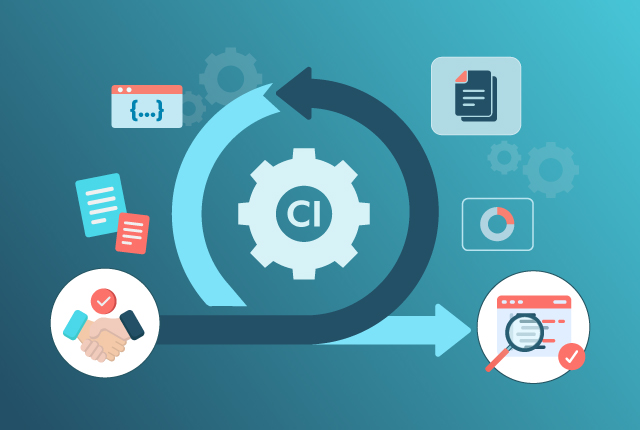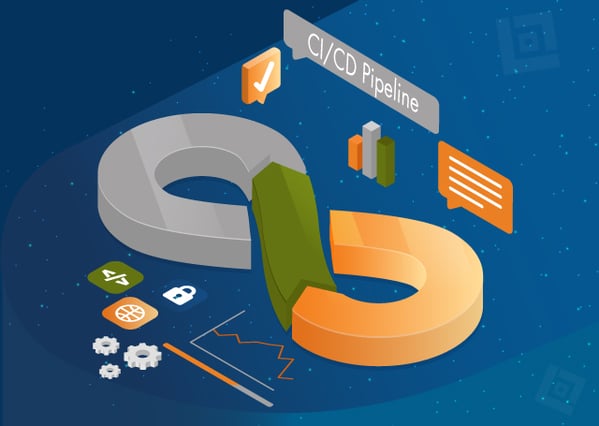
Table of Contents
- What is continuous integration testing?
- Key components of continuous integration testing
- Advantages of continuous integration testing
- Process of continuous integration testing
- Top continuous integration tools in 2025
- Different types of CI tests
- Challenges of continuous integration testing and solutions
- How to proactively manage continuous integration testing
- Continuous integration testing with QASource
- Benefits of partnering with an external QA service
- Conclusion
What if you could build a safety net that protects your product’s user experience without slowing down development? Continuous Integration (CI) testing makes that possible.
By integrating testing into every development cycle, CI enables teams to catch bugs early, reduce delays, and deliver high-quality software more quickly. Instead of risking defects in production, CI enables continuous testing, ensuring stability while maintaining speed to market.
In this guide, we’ll break down everything you need to know about continuous integration testing.
What is Continuous Integration Testing?
Continuous integration is a software development practice that automatically tests code changes as they are frequently integrated into a shared repository. The continuous integration process encourages small changes more often instead of committing significant changes intermittently. Developers typically use continuous integration tools to integrate code changes multiple times each day, triggering continuous integration QA testers to perform tests that identify if any bugs or defects arise from the updated code base.
What is continuous integration without continuous delivery? While Continuous Integration focuses on the frequent merging and automated testing of code changes, Continuous Delivery (CD) extends this by ensuring that these tested changes can be reliably and efficiently deployed to production environments. In other words, your team can quickly release your builds, ready for market, with just one click.
Key Components of Continuous Integration Testing
Continuous Integration testing combines automated testing with the CI pipeline, where code changes are constantly integrated and validated. This ensures frequent feedback on quality and functionality, improving software development overall. Here are the key components of successful CI testing:
-
Version Control System (VCS)
A VCS like Git tracks code changes and supports collaboration. All code should be stored in a central repository, making it easier to manage changes and trigger automated testing pipelines.
-
Automated Quality Checks and Build System
Integrating static code analysis tools (e.g., SonarQube, Checkstyle) into the CI pipeline helps identify potential code quality issues and security vulnerabilities before integration. This system compiles the code and assembles it into an executable format. It validates whether the new code integrates without breaking the build.
-
Test Automation Framework
Automated tests, including unit, integration, and functional tests, are executed every time new code is committed. This framework ensures tests are repeatable, fast, and scalable. A balanced test automation pyramid, encompassing unit, integration, and end-to-end tests, ensures comprehensive coverage.
-
Continuous Integration Server
CI servers, such as Jenkins, CircleCI, or GitLab CI, monitor the version control system for changes. When new code is pushed, it automatically triggers builds and runs tests.
-
Feedback Mechanism
Immediate feedback is crucial. Developers are notified in real-time if the build fails or if any tests break. This helps fix issues quickly and maintain code quality.
-
Reporting and Logging
Detailed test reports and logs help teams understand what failed and why. This visibility is vital for troubleshooting and improving future tests.
-
Environmental Consistency
CI pipelines must run in consistent environments. Using containers (e.g., Docker) or virtualization helps ensure that tests behave consistently across all systems.
-
Integration with Deployment Pipelines
Although CI focuses on testing, it often integrates with Continuous Deployment (CD) pipelines to support full automation from code to production.
Advantages of Continuous Integration Testing
Continuous integration (CI) testing offers various advantages for software development teams, improving efficiency, quality, and overall workflow, and delivering a better product. Here are some of the key benefits:
- Increase Your Testing Coverage: Testing most of your code base isn’t enough. A CI server can review your codebase for test coverage, exposing which parts of the code still require testing.
- Identify Integration Challenges Earlier: In many development cycles, testers have to wait weeks to test and discover defects within the code. Continuous integration teams have developers update code regularly, and testers utilize continuous integration tools to routinely check the code for issues, making it easier to identify problems so developers can resolve them sooner. CI also prevents developers from building code on top of defective code.
- Decrease Time Spent Reviewing Code: Continuous integration QA can be set up so that your CI and Version Control System communicate with each other and notify you when a merge request is approved, meaning all tests have passed and the code meets all requirements. The difference in code coverage can be reported directly from the merge request, effectively reducing the time required to review it and allowing reviewers to focus on logic and design rather than basic quality issues.
- Faster Feedback Loops: It’s challenging for developers to prioritize code changes without receiving feedback on their previous ones. Waiting too long to test the code can make it difficult to pinpoint where the issue lies in the code and who made those changes. Continuous integration enables QA testers to provide developers with timely feedback, allowing them to resolve destructive code more efficiently.
- Ensure a Positive User Experience: With so much variety in the marketplace, consumers do not have to settle for your software application’s shortcomings. Fortunately, continuous integration is designed to deliver bug fixes and new features to users more quickly.
Process of Continuous Integration Testing
Continuous Integration testing involves seamlessly integrating testing practices into your continuous integration pipeline. Here's a breakdown of the key steps. CI testing affects a specific workflow that ensures continuous verification and quality assurance throughout the development cycle. Here's a breakdown of the key steps: The process of continuous integration testing can be broken down into a few key steps:
- Code Commit: A developer makes changes to the codebase and commits them to a version control system like Git.
- Trigger Build: This action triggers the CI server, automatically initiating the build process.
- Build and Compile Code: The CI server retrieves the latest code, compiles it into an executable form, and creates artifacts like packages or installers.
- Run Unit Tests: Automated unit tests run against the compiled code, verifying the functionality of individual modules or functions.
- Integration Tests: If unit tests pass, integration tests are executed to check how different components interact and function together.
- Functional and Performance Tests: Depending on your pipeline, broader tests, such as functional and performance tests, may run at this stage, assessing the overall user experience and system behavior under load.
- Security Tests: Security tests, such as static analysis and vulnerability scans, can also be integrated to identify potential security flaws early in the process.
- Results and Reporting: All test results are consolidated and reported to developers, highlighting failures or regressions.
- Review and Fix: Analyze the reports, identify and address any issues, and potentially rerun specific tests to confirm the fixes.
- Optional Deployment: Based on your CI/CD pipeline, successful builds with passing tests might automatically trigger deployment to testing environments or even production, following further manual reviews and approvals.
Points to Remember:
- The specific tests and tools will vary depending on your project and team needs.
- Continuous integration testing is an ongoing process, not a one-time event.
- Continuously refine your CI pipeline to optimize testing effectiveness and efficiency.
By implementing CI testing, you can build a robust software development process, ensuring high-quality and secure products are delivered faster.
Top Continuous Integration Tools in 2025
Dozens of automation offerings are available across licensed and open-source solutions, each with unique features and capabilities. Because making the right choice is crucial to following CI best practices and overall building success, we recommend reviewing these continuous integration tools during your selection process.
- Jenkins
- GitLab CI
- CircleCI
- Wercker
- Bamboo
Different Types of CI Tests
Continuous integration (CI) has diverse testing approaches that work together to ensure the quality and security of your codebase. Here's a breakdown of the five key types of CI tests:
-
Unit Testing
Focuses on individual units of code (functions, classes, modules). Fast and easy to write and maintain. Unit testing verifies the correctness of each unit in isolation. For example, test a function that calculates the factorial of a number.
-
Integration Testing
This test determines how different units of code interact with each other. Ensure seamless interaction between components. It's more complex than unit tests but still relatively fast. For example, you are testing how a shopping cart component interacts with a payment gateway.
-
Functional Testing
Functional testing verifies the system's overall functionality from a user's perspective. Test features and workflows as a whole. It may involve user interface (UI) testing and API testing. For example, you are testing the checkout process of an e-commerce website.
-
Performance Testing
Evaluate the system's performance under load. Measure metrics like response time, throughput, and resource utilization. Help identify bottlenecks and ensure scalability. For example, you test a web application's performance under high-traffic conditions.
-
Security Testing
Identify and address potential security vulnerabilities in the system. Includes static code analysis, penetration testing, and vulnerability scanning. It is crucial for protecting sensitive data and preventing cyberattacks. For example, testing a web application for SQL injection vulnerabilities.
Continuous testing is made feasible by the increased frequency of test runs in a continuous integration pipeline. It is wise to bring your initial set of tests into a continuous integration (CI) pipeline if you are just getting started or are still learning about CI and integrating test coverage.
Challenges of Continuous Integration Testing and Solutions Offered by QASource
An effective continuous integration process doesn’t happen overnight. To receive all the benefits of continuous integration QA, your team must have a plan on how to overcome these common challenges:
-
Extensive Planning: Because your team tests more often and for shorter intervals, QA must be factored into the overall development plan early and often and should be included when selecting the right continuous integration tools.
Solution: A comprehensive strategy must be in place so everyone on the team understands each step of the new workflows and internal processes. While this takes time to deliver, you can expect time-saving results within your upcoming development cycles.
-
Resistance to Team Coordination: Continuous integration testing can initially disrupt developers' workflows. Engineers accustomed to completing code tasks and handing over a final product for testing may often resist change.
Solution: To overcome this hesitancy, consider explaining the benefits of the continuous integration model to your developers and QA engineers. For example, continuous integration QA provides greater transparency into your test environment, helping developers receive regular feedback and QA testers gain more insight for solving problems during testing. Emphasizing the benefits of early feedback, increased code quality, and reduced rework can help overcome resistance and foster a collaborative environment between development and QA teams.
-
Infrastructure Investments: A team can only scale with continuous integration when there is a budget to support it. The infrastructure is needed to accelerate delivery and increase product quality.
Solution: To gain internal buy-in for funding a CI infrastructure, present the benefits to your key stakeholders in terms of the overall business. It can include the expected return on investment (ROI) and your game plan for achieving it.
-
Creating Reliable and Repeatable Workflows: Transitioning your workflows to a continuous integration pipeline can be challenging, especially for large-scale, legacy projects. Changing one part of your workflow may impact several other processes across your team.
Solution: Talking through these challenges with your internal experts across teams can help you devise solutions for creating reliable, repeatable CI workflows.
-
Data Overload: There is no shortage of information in continuous integration and QA. However, this influx of data can paralyze your team, making it difficult for them to sort through and act upon it.
Solution: First, focus on the test analytics surrounding platform usage and test suite efficiency to understand which test cases detect the most defects. Secondly, analyze which tests constantly fail to overcome this challenge. Implementing effective visualization tools and dashboards can help teams quickly identify trends and prioritize actions.
Additional Considerations
- Infrastructure and Resources: Choose tools and practices that align with your infrastructure and available resources.
- Change Management: Prepare and manage the transition to CI testing effectively, addressing potential concerns and resistance to ensure a seamless implementation.
- Metrics and Monitoring: Monitoring key metrics, such as test coverage, execution time, and defect detection rate, is essential for assessing the effectiveness of the CI testing process and identifying areas for optimization. Pipeline stability is also crucial for this assessment.
How to Proactively Manage Continuous Integration Testing
Managing CI testing effectively means planning for speed, scale, and quality from the start. Here’s a step-by-step approach to set your team up for long-term success:
Step 1: Start Early with a Scalable Strategy
Begin integrating CI practices as early as possible in the development cycle. Early adoption makes building efficient, repeatable methods that scale with your project easier. Define workflows and integration patterns that can evolve as your codebase grows.
Step 2: Automate All Tests
Automation is the backbone of CI. Set up automated unit, integration, and regression tests to run with every code commit. This ensures continuous validation without manual intervention, keeping development fast and reliable.
Step 3: Align the Entire Team
Ensure that developers, testers, and DevOps engineers are aligned on CI goals and processes. Use shared tools and regular syncs to inform everyone about updates, changes, and build results.
Step 4: Prepare for Continuous Delivery
CI works best when paired with Continuous Delivery (CD). Design your pipeline to automatically stage successful builds for deployment. This reduces delays between development and production.
Step 5: Bring in a QA Partner Early
An experienced QA partner can support your CI implementation by:
- Recommending the right CI automation tools
- Designing and maintaining scalable test suites
- Creating efficient workflows between development and testing
Their expertise helps prevent CI bottlenecks and ensures testing doesn’t slow the release cycle.
Step 6: Use Offshore QA Teams to Your Advantage
With offshore QA support, you can:
- Run tests overnight across time zones
- Receive test reports by the next morning
- Maintain a continuous feedback loop. This 24-hour development cycle increases efficiency and accelerates releases.
Step 7: Optimize for Cost and Scale
QA experts can ramp up testing quickly during high-demand periods. Their deep understanding of your tech stack and business needs allows them to deliver targeted solutions while reducing costs, often cutting QA spending by up to 50%.
Continuous Integration Testing with QASource
Explores the potential of Continuous Integration (CI) testing and partners with an external QA Service expert. QASource has a team of testers and engineers dedicated to enhancing the workflow and promptly driving the product's quality through its expert QA services. Here are some key questions:
Some key considerations to keep in mind when selecting an external partner for implementing CI testing.
- CI Testing is Not a One-Size-Fits-All Solution: The optimal approach will depend on your unique needs and resources.
- Start Small and Iterate: It's often best to start with a simple CI setup and gradually add complexity as you gain experience.
- Communication and Collaboration are Essential: Get buy-in from all stakeholders and ensure everyone understands the benefits and potential challenges of adopting CI testing.
- Focus on Value, Not Just Metrics: Don't get bogged down in measuring everything. Focus on metrics that directly contribute to your development goals.
Benefits of Partnering with an External QA Service
- Expertise: Leverage their specialized knowledge and experience in various testing methodologies and tools.
- Scalability: Access a larger pool of testers to handle peak workloads or specific testing needs.
- Cost-effectiveness: Pay only for the services you need, avoiding the overhead costs associated with hiring full-time staff.
- Objectivity: Gain fresh perspectives and insights to identify issues in internal test.
Conclusion
Managing continuous integration (CI) testing effectively requires a balanced approach to testing and collaboration. By implementing the aforementioned strategies, you can establish a robust CI pipeline that delivers high-quality software more quickly and efficiently. Remember, continuous integration testing evaluates, adapts, and improves your process to unlock its full potential, empowering your team to deliver exceptional software. Leveraging QASource’s expertise to create a valuable resource for optimizing their CI testing processes and achieving better results.


